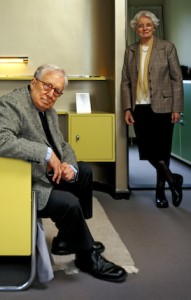
The Pritzker Architecture Prize
In 1979, Jay Pritzker, American Entrepeneur, created the Pritzker Prize. Arguably the most significant contemporary recognition in the field of architecture, it’s official purpose is as follows:
To honor a living architect/s whose built work demonstrates a combination of those qualities of talent, vision, and commitment, which has produced consistent and significant contributions to humanity and the built environment through the art of architecture

Toyo Ito
This year’s prize goes to Toyo Ito, whose recognition in 2013 for a lifetime of excellent work, including my personal favorite, Sendai Mediatheque, a library in Japan, among many, many other notable works. Unfortunately, Ito’s accomplishment and recognition this year will be overshadowed by a controversy that’s been twenty-two years in the making.

Venturi Scott Brown
This brings us to the firm Venturi Scott Brown & Associates, and more specifically the awarding of the 1991 Pritzker Prize to Robert Venturi. The exclusion of his longtime partner and spouse, Denise Scott Brown, was immediately controversial. Brown did not attend the award ceremony in protest. The reason given at the time indicated that the award only honored indivual architects. This is a particularly weak argument, given the 1988 joint recognition of Oscar Niemeyer and Gordon Bunshaft.
Over two decades later, a couple of Harvard Graduate School of Design students, Arielle Assouline-Lichten and Caroline James, launched an online petition demanding that the Brown be retroactively acknowledged for her contributions. It’s worth noting, the petition was to recognize Brown’s contributions, not to retroactively award the prize to Denise Scott Brown.
Last Friday, the Pritzker Architecture Prize Committee delivered its official response to the petition. The already notable outrcy from the architectural community, including the signatures of nine past laureates, has only gotten louder. The nuances of the response are calculated, and Lord Peter Palumbo appears to have tried valiantly to diffuse the situation without giving into the demands of the petition.
Thank you for sending your petitions and letters, and those of others, about Ms. Denise Scott Brown and the Pritzker Architecture Prize. Insofar as you have in mind a retroactive award of the prize to Ms. Scott Brown, the present jury cannot do so.
While this is an apparent a misdirection of the intent of the petition itself, the committee did recognize some value of the protest itself, and it’s highlighting of a major shortcoming of the architectural community as a whole.
That said, we should like to thank you for calling directly to our attention a more general problem, namely that of assuring women a fair and equal place within the profession. To provide that assurance is, of course, an obligation embraced by every part of the profession, from the schools that might first encourage students to enter the profession to the architectural firms that must facilitate the ability of women to fulfill their potential as architects. We believe that one particular role that the Pritzker Jury must fulfill, in this respect, is that of keeping in mind the fact that certain recommendations or discussions relating to architectural creation are often a reflection of particular times or places, which may reflect cultural biases that underplay a woman’s role in the creative process. Where this occurs, we must, and we do, take such matters into account.
Too little and too late? Architectural historian and theorist Kazys Varnelis certainly believes so, even going so far as to declare the Pritzker Prize “a detriment to the profession.” He further suggest the dismantling of the prize as-is, and rethinking the use of Pritzker’s legacy to further the profession of architecture in a different way.
It’s time to shut the Pritzker down and give that to people who need it, not to a bunch of well off sad, white men. Why not put take the list of countries ranked worldwide by GDP and distribute the money to needy students in countries in the bottom half? Jay Pritzker’s money would be doing much more for the profession.
Also notable, is the fact that every time Robert Venturi has been put forward for the highest award given by the American Institute of Architects, the Gold Medal, the two have responded to the AIA as a team. Those responses have been returned, unopened.
Time will tell whether this decision represents any significant change to the Pritzker Prize itself, and what impact the whole situation will have on the profession as a whole going forward. As a father of two daughters myself, and having several close female friends within the profession, I pray that this dialog represents a shift in the tide, and that we leave the profession a better, more equal place for future generations. A statement made by one of my professors back in college, speaking on architectural recognition and the long, slow nature of a successful architectural career, gave the class the following tidbit of wisdom:
Architecture, is an old man’s game.
At the time, I recall a swelling sense of frustration about the slow-moving nature of the profession, and what it means to be successful in the field. I now see a blatant oversight on my part, and an underlying bias that I previously missed.
Here’s to you Ms. Brown, and all the other underappreciated and extremely talented women who have contributed more to the practice of architecture than we will ever know.